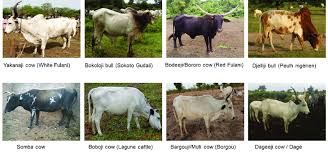This article discusses the various breeds of cattle with a particular focus on tropical Nigerian breeds. Cattle breeds vary from one region or ecological zone to another, having adapted to the specific conditions of those zones.
A breed is defined as a group of animals with a common origin, sharing distinct features within the same species. These characteristics remain consistent as they are passed down through generations, making it important to understand them.
Recognising whether a breed is for dairy or beef is essential for proper management practices aimed at improving productivity.
Read Also: Predators, Parasites and Diseases of Snail and Controls
Nigerian Breeds of Cattle

The breeds of cattle found in Nigeria can be grouped into different categories, as outlined below.
1. N’dama: This breed spread to most parts of West Africa from the Fouta Djallon highlands of Guinea. It has adapted well to the rainforest conditions and extends southwards to the limit of Zebu distribution. It is a small, limbless, well-built animal with a straight top line and short, fine limbs.
The coat is usually yellow, fawn, or light red. The female’s udder is very small and positioned high between the legs. N’dama cattle are poor milkers, producing a maximum of 450 kg. They are occasionally used for draught but are primarily beef animals. They are tolerant to trypanosomiasis but tend to break down under stress. Their meat is of good quality. Mature live weight ranges between 230–420 kg.
2. Kuri:This breed is limited to the Lake Chad area and parts of Borno State. Kuri cattle inhabit the islands and shores surrounding Lake Chad. They are tall animals with very large, circular or bulbous horns that are thick at the base and humpless.
The horns are light and hollow and are believed to aid in swimming across the lake. Kuri cattle are used for both meat and milk, with an average lactation yield of 600–700 kg and a live weight of up to 650 kg. They are not suitable for draught work. Their coat is usually white or light grey, sometimes with dark spots on the flanks.
3. White Fulani (Bunaji): An indigenous breed predominantly found in Northern Nigeria, White Fulani accounts for about half of the national cattle population. It adapts well to various environmental conditions.
The breed is fairly large, standing at about 130 cm tall. Bulls weigh around 500 kg, while cows average 325 kg. The hump is large and well-developed, the navel flap is small, and the horns are medium in length and lyre-shaped. The coat is typically white.
White Fulani is a triple-purpose breed used for milk, meat, and draught. It produces up to 2,300 kg of milk per lactation. Crossbreeding with Holstein at NAPRI-Shika, Zaria has resulted in increased milk production. The age at first calving is between 42–45 months, although in Fulani herds it may be as late as five years. This breed supplies a large portion of beef consumed across Nigeria.
4. Sokoto Gudali:This breed is mainly found in the former Sokoto Province (now Sokoto State) and is also known as Bokologi. It is a medium-sized, short-horned breed with a pronounced hump and navel fold. The typical coat colour is greyish-white or creamy, with short hair and thick, pigmented skin.
The ears are pendulous. Sokoto Gudali cattle are good milk producers, with milk yield at Shika (NAPRI) exceeding that of White Fulani. They have a calving interval of 360–450 days and are also suitable for beef production. Mature live weight ranges between 300–550 kg.
5. Muturu: Muturu is a West African dwarf short-horn breed found in coastal regions of West Africa. It is trypanotolerant and humpless, typically having a dark brown or black coat. The body is compact and hardy. Mature bulls can weigh up to 300 kg. In many local communities, this breed serves a scavenger role due to its resilience. Other cattle breeds found in Nigeria include Keteku, Adamawa Gudali, and Red Fulani (Rahaji).
Read Also: Basic Snail Farming Tools and Equipment
Specialised Cattle Breeds for Milk and Meat Production

In developed countries, cattle breeds have been selectively improved to specialise in either milk or meat production. Below are examples of these specialised breeds.
A. Beef Cattle Breeds (Exotic)
These breeds are not native to Nigeria but are known for their beef quality.
1. Hereford: Originates from England; coat colour ranges from light to dark red with a white face.
2. Brahman: An American Zebu breed, mostly white in colour.
3. Aberdeen Angus: Native to Scotland; black in colour and naturally polled. Matures early and produces high-quality carcass meat.
B. Dairy Cattle Breeds (Exotic)
Five major dairy breeds are common in various parts of the world.
1. Holstein-Friesian: Originated from Holland; mostly black and white coat. It is a major dairy breed. Cows weigh around 567 kg and bulls up to 816 kg.
2. Jersey: Originated from the Island of Jersey in Britain; light brown to black coat with a distinctive black muzzle and white ring. It is the smallest of European dairy breeds.
3. Guernsey: Originated from the Channel Islands; light brown to red with white markings on the face, legs, switch, and flank.
4. Ayrshire: Characterised by red and white variegated coat colours.
5. Brown Swiss: Originated from Switzerland; coat colour ranges from light brown to nearly black.
Do you have any questions, suggestions, or contributions? If so, please feel free to use the comment box below to share your thoughts. We also encourage you to kindly share this information with others who might benefit from it. Since we can’t reach everyone at once, we truly appreciate your help in spreading the word. Thank you so much for your support and for sharing!
.
Frequently Asked Questions
We will update this section soon.

